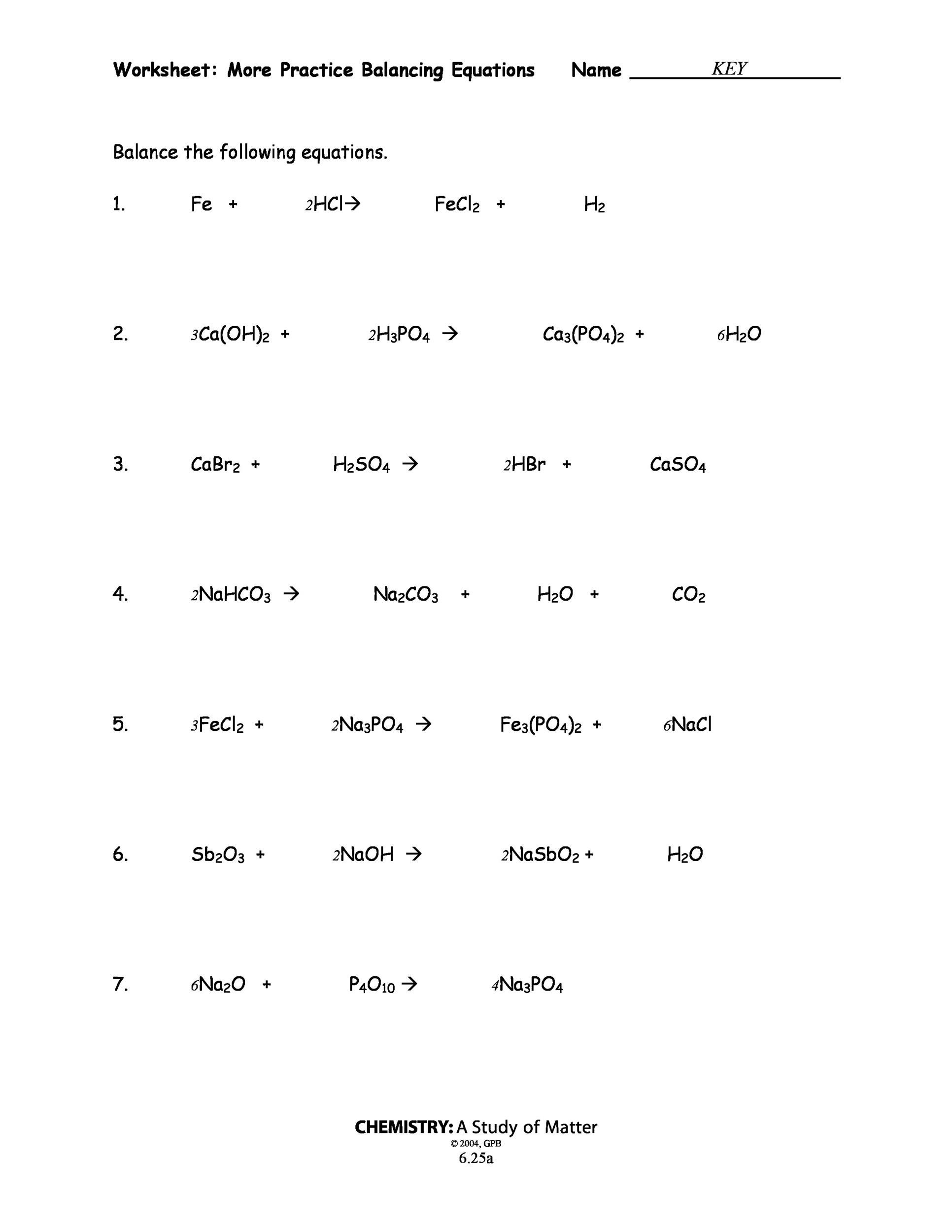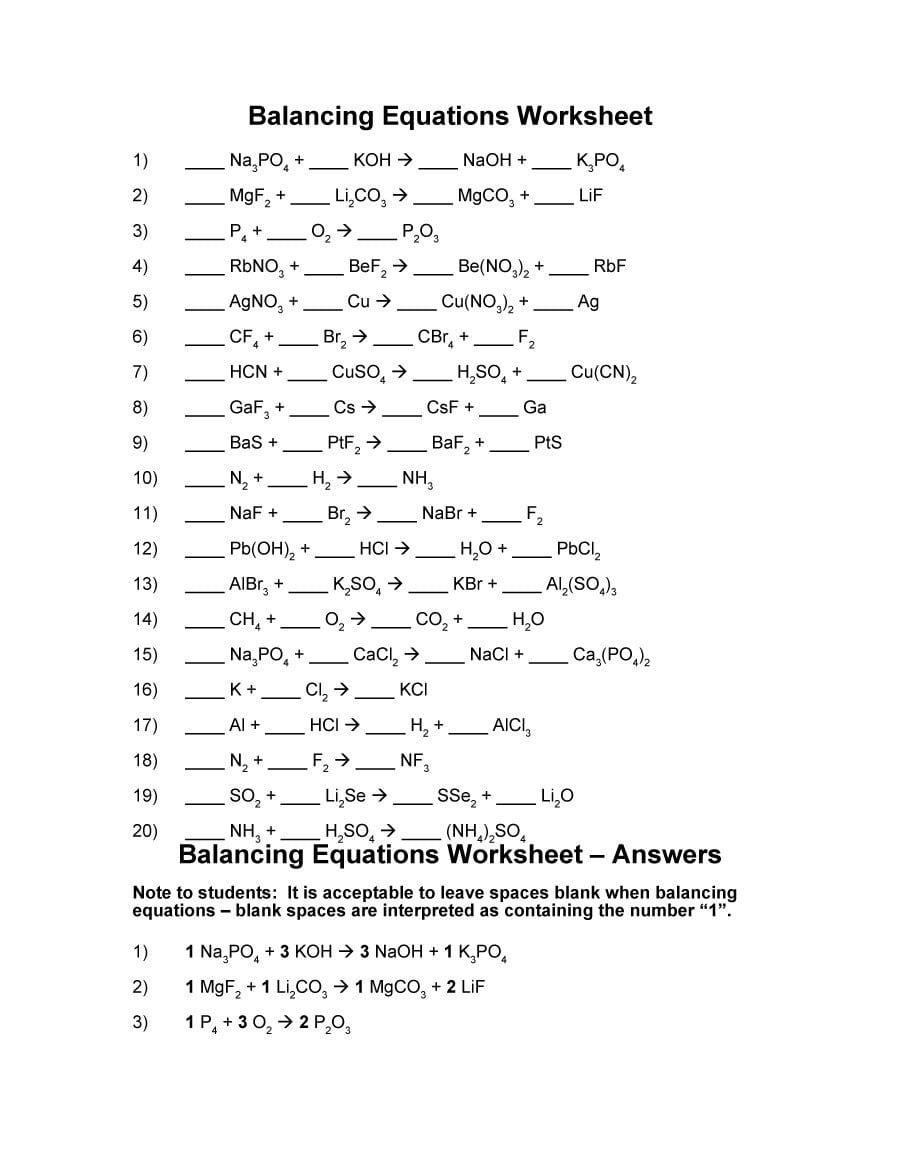Remember that time in high school chemistry when the teacher introduced chemical equations? It seemed like a foreign language, full of symbols and numbers that just didn’t make sense. But then, a lightbulb went off – balancing equations wasn’t just about memorizing formulas, it was about understanding the fundamental principles of chemical reactions. That’s when the magic of chemistry clicked for me. From then on, solving balancing equations worksheets became a puzzle, a challenge, and a way to connect with the intricate world of chemical reactions.

Image: quizzlistmoore.z13.web.core.windows.net
Balancing equations is a fundamental skill in chemistry, much like understanding grammar is essential for writing a good essay. It’s a process that ensures the number of atoms of each element on the reactant side of a chemical equation equals the number of atoms of that same element on the product side. This principle, known as the Law of Conservation of Mass, tells us that matter cannot be created or destroyed in a chemical reaction. Mastering this skill is key to unlocking a deeper understanding of chemical processes and reactions.
Understanding the Importance of Balancing Equations
Imagine trying to bake a cake without knowing the correct proportions of ingredients. Without a recipe, you might end up with a doughy mess, or worse, something that doesn’t even taste like cake. Balancing chemical equations is similar; it’s the recipe that ensures the reaction proceeds correctly and produces the desired products.
Balancing chemical equations serves several critical purposes:
- Ensures the Law of Conservation of Mass: By making sure the number of atoms on both sides of the equation is equal, we guarantee that no atoms are lost or gained during the reaction. This law is fundamental to understanding the behavior of matter.
- Predicts the Products of Reactions: A balanced equation provides a clear picture of the chemical reaction, showing both the reactants and products involved. This allows us to anticipate what substances will be produced.
- Determines the Stoichiometry of Reactions: Balancing equations is crucial for determining the exact ratios in which reactants combine and products are formed. This information is essential for conducting laboratory experiments and scaling up chemical processes in industrial settings.
Breaking Down the Balancing Equation Process
Balancing chemical equations might seem like a daunting task at first, but with a structured approach, it becomes a straightforward process. Let’s break it down into manageable steps:
1. Identify the Reactants and Products:
Start by carefully identifying the reactants and products involved in the chemical reaction. These are often listed in the problem or experiment description. For example, in the reaction of sodium chloride (NaCl) with silver nitrate (AgNO3), the reactants are NaCl and AgNO3, and the products are sodium nitrate (NaNO3) and silver chloride (AgCl).

Image: printablezonefeigns.z13.web.core.windows.net
2. Write the Unbalanced Chemical Equation:
Using the chemical formulas for the reactants and products, write an unbalanced equation. For instance, the reaction above would be written as:
NaCl + AgNO3 → NaNO3 + AgCl
3. Count the Number of Atoms for Each Element on Both Sides:
Carefully count the number of atoms of each element on both the reactant and product sides of the equation. In the example above, there is:
* 1 Na atom, 1 Cl atom, 1 Ag atom, and 1 N atom on both sides.
* 3 O atoms on both sides.
4. Balance the Equation by Adjusting Coefficients:
Start by balancing the most complex element or the one that appears in the most compounds. Use coefficients (the numbers that precede the chemical formulas) to adjust the number of molecules of each reactant and product until the number of atoms of each element on both sides is equal. Remember, you can only adjust coefficients, not subscripts within the chemical formulas.
For the reaction above, the equation is already balanced. However, if the number of chlorine atoms on both sides was not equal, we could balance it by adjusting the coefficient in front of NaCl or AgCl.
5. Double-Check Your Work:
Always double-check your work to ensure that the equation is correctly balanced. Make sure the number of each element on the reactant side equals the number of the same element on the product side.
Tips and Expert Advice for Balancing Equations Mastery
The ability to balance chemical equations doesn’t just happen overnight. It requires practice and a few key strategies. Here are some tips from my experience:
1. Start with Simple Equations:
Don’t dive into complex equations right away. Start with basic reactions involving a few elements and gradually increase the complexity as you gain confidence.
2. Use a Systematic Approach:
Follow a clear and structured approach, such as the steps outlined earlier. This will prevent mistakes and ensure you are balancing each element meticulously.
3. Visualize the Atoms:
Try to visualize the atoms involved in the reaction. This can help you understand how the coefficients adjust the number of atoms on each side of the equation.
4. Practice Regularly:
The more equations you balance, the more proficient you’ll become. Practice regularly, and you’ll start to recognize familiar patterns.
Frequently Asked Questions
Q: What happens if an equation can’t be balanced?
A: If an equation can’t be balanced, it often means there is an error in the chemical formulas of the reactants or products. Double-check the formulas and make sure they are correct.
Q: Is there a specific order to balance elements?
A: While there isn’t a fixed order, it’s often helpful to start with elements that appear in the most compounds or that are the most complex. For example, you might balance oxygen and hydrogen last, as they often appear in multiple compounds.
Q: What are some common mistakes to avoid when balancing equations?
A: Common mistakes include:
* Changing subscripts in chemical formulas. Subscripts represent the number of atoms in a molecule and should never be changed when balancing an equation.
* Ignoring charges in ionic compounds. Make sure that the total charge of the reactants equals the total charge of the products.
Balancing Equations Worksheet 1 Answer Key
Conclusion
Balancing chemical equations is an essential skill in chemistry, providing a window into the elegance and precision of chemical reactions. By following a structured approach and practicing regularly, you can master this skill and unlock a deeper understanding of the language of chemistry. So, put on your chemist’s hat, grab your worksheet, and get ready to conquer the world of chemical equations!
Are you interested in learning more about balancing chemical equations and other essential chemistry concepts? Let us know in the comments below!






